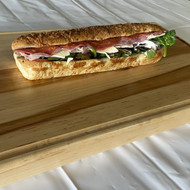Will My Cutting Board Warp? Six Reasons the Answer Is 'No'
12th Oct 2025
We often get concerns from potential customers about our one-piece cutting boards warping, "cupping," or moving away from their original flat shape due to water or excess humidity. This warping anxiety often comes, understandably, from those with some woodworking knowledge or experience.
It's true that all wood, exposed to enough water, will warp, and we have seen pieces of Treeboard's lumber warp when left outside, unfinished in the rain for a season.
But we have been making our cutting boards for years without customer complaints about warping.
Here are six reasons why we believe don't have warping:
-
The boards are large, dense, and strong so it would require a large amount of water getting inside the tight-packed grain to "cup" them. These aren't thin floorboards or lightweight pine, where the grain will more easily "move" when exposed to the elements.
-
The lumber is kiln-dried by a firm of accredited professionals in Pennsylvania who know their craft. They get us only the best firsts-and-seconds grade hard maple and white oak, and we cut around any rare knots or other significant flaws that destract from the beauty or cutting surface.
-
Our customers' houses are typically climate-controlled. Any water that goes in probably evaporates between uses. (I'd hate to send a cutting board immersed in water for days, then left in an unairconditioned beach house during a humid hurricane season.)
-
We normally finish every board that we ship, applying extra oil and wax to the vulnerable end-grain. (And we warn customers who requested unfinished boards to use their favorite coconut oil or whatever.) Each board comes with a complimentary board balm.
-
We encourage the use of feet to keep the boards out of puddles, etc., and they come free with the large boards. Resting the board on feet (or propping it up on its side) also allows the board to air-dry all around and get rid of excess water.
-
Every board comes with lengthy instructions about not immersing it, etc.
We have had a few reports of tiny splits or "checking" on the end-grain in the past, but those reports have nearly disappeared of late as our woodworker searches every piece of lumber for microcracks and planes through them or trims them off. In the event something unpleasant happens early on or due to inherent problems with the board, we replace it free of charge.
We're not sure why folks are so concerned about one-piece boards. Don't forget—when ordinary glue-together boards are exposed to excess water, the normal result is warping of the component pieces and splitting at the seams. So while the composite board may stay relatively flat it can still be destroyed.
Probably those who are concerned have been told that plywood is stabler when exposed moisture than a single piece of lumber. This is true, but who wants a toxic plywood cutting board?

